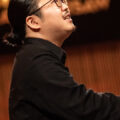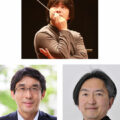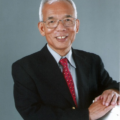On Curling’s Ritualistic Culture and its Social Media Fan Culture
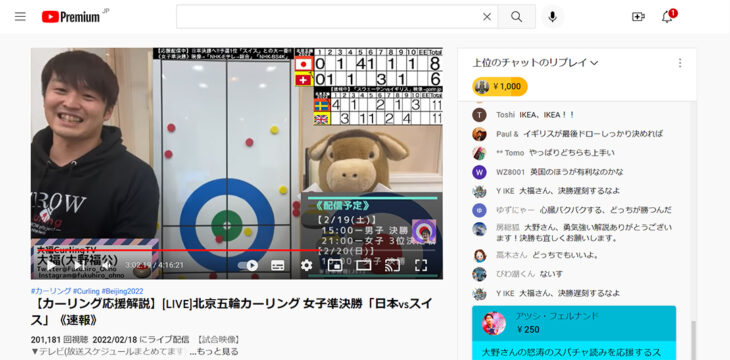
A scene from the Youtube cheering commentary of the Beijing Olympic Women’s Curling Semifinal match by curling player Ohno Fukuhiro (distributed on February 18, 2022)
Courtesy of Ohno Fukuhiro, Daifuku Curling TV
Hase Masato, Professor, Waseda University
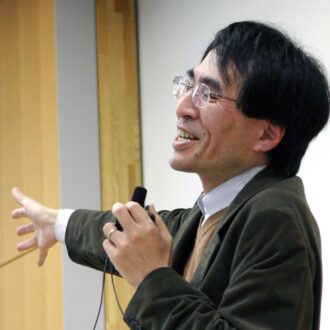
Prof. Hase Masato
I believe curling’s charm lies in how we can sense traditional “culture” in it. Of course, as a television viewer, my pleasure in watching curling undoubtedly comes from its aspect as a “game,” in which a contest of high skill determines victor and vanquished. Helped along by the commentators, I can appreciate the refreshing feeling when multiple of the opponents’ stones are repelled in a double takeout; the ingenuity of trained muscles executing a sweep to control the speed and direction of a draw; and the complexity of a strategy that attempts to places guards in a way to create an advantage. This understanding allows me to enjoy curling as a sports game. Of course, in the case of the recent Beijing Olympics, as I cheered, “Come on, Loco Solare!” I also certainly watched curling with the elevated spirits of a person rooting for his national team.
Yet I sense there is definitely something more to “watching” curling than feeling the pleasure of watching a “game.” This is because when we watch curling, we also watch a culturally-ordered space that is governed by “ritual” (similar to sumo or judo). For example, even when the match is over, we rarely see winners express their joy with triumphant gesturing. It is customary for the competitors to, first, say to each other “good game” and undertake the formality of “shaking hands” (though COVID-19 counter-measures turned this into a fist bump at the Beijing Olympics) before going into their celebrations (you can see something similar when the referee calls “full time,” formerly “no side,” in a rugby game).
Even in a contest with nationalistic stakes (medals) such as the Olympic playoffs, contestants strive to faithfully obey these rituals. When Eve Muirhead (who won gold at the 2022 Olympics) missed her last shot in the women’s third-place playoff that many Japanese watched during the 2018 PyeongChang Olympics, thus handing Japan the bronze and leaving England sans silverware, the English curlers’ first act was not to show frustration, but to offer their hands to their Japanese opponents for a shake. Losers showing frustration before shaking hands, or winners engaging in emotional behavior such as celebrating (an opponent’s miss) goes against ritual, and it is tradition rather than rules that enforces these prohibitions (the rulebook contains a preface that begins by explaining the philosophy of the “Spirit of Curling”). In curling, a traditional philosophy of sportsmanship concerning fairness and amateurism continues to find an extremely concrete expression inside the game. I believe it was that materialization of amateur sports-like ritualistic formalism, which possessed a charm that punctured the space of Olympian nationalism (i.e., medal-squabbling) and professionalism, that so rattled my sensitivities.
These rituals that one can say are unique to curling (and similar to those found in golf) and redolent of British aristocratic sportsmanship, can also be frequently seen in the action of the game. I began devotedly watching curling after the PyeongChang Olympics, and what first surprised me was when, during the men’s Japan vs. U.S. (Team Shuster that won gold in PyeongChang) match in the World Curling Championships that took place a month later, Aoki Go (Team Iwai) won a point after completing a difficult angle raise, and two of the U.S. curlers scurried up to him (faster than his own teammates) to offer high fives and “nice shots.” I’d never been so startled watching a sports game. Indeed, there is a ritualistic rule in curling according to which players must praise their opponents’ “nice shots” (perhaps there is a similar rule in golf). Yet, rather than as a mere performance of ritual, the two U.S. curlers offered their high fives filled with what was by all appearances the sincere excited sentiment of, “Man, you’re awesome for your age!” In other words, complimenting the opponent’s shot was not just a matter of principle, but seemed to be built into the game as a necessary cultural condition of playing the game joyfully. After stumbling upon this incident, I started to watch matches while paying more attention to the idiosyncratic culture of the sport of curling.
Why does this ritualistic culture endure in curling?[1] The reason is that the sport of curling is blessed with an intimate sports tradition widely beloved by Canadians, one that inhabitants of countless small towns in the Canadian plains enjoy together with socializing, drinking, and dancing in the harsh winters. In Canada, countless small towns have curling rinks, and even today there are around 1,000 curling clubs in total. It is said that there are over one million active curlers of all ages and genders in Canada. In other words, curling culture has been enjoyed in Canada not as a sport of high-level “plays” performed by professional athletes that one “watches” (like the popular ice hockey), but as a sport one “does” as a form of socializing that emphasizes ritual (local volunteers organize Bonspiel held in rinks with sparse attendance in the countryside, while the big competitions “to watch” are broadcast on television and occur in ice hockey rinks). Since Canadians have historically participated in curling as a local grassroots sport one “does,” the ritualistic philosophy of sportsmanship and amateurism the Scottish immigrants introduced has been kept alive in the social life of the countryside.
In the case of curling today, even the strong teams such as those that compete in the Olympics and World Championships do not consist exclusively of young athletes at the height of their physical fitness, as is the case in skiing and skating. Watching athletes of a variety of ages and body-types compete, each with unique traits, is actually quite fun (although very recently there has been a trend towards athleticization). In particular, the “skip” position demands knowledge of strategy along with a certain experience quotient and equanimity, and often older, veteran curlers take on this role (they are also not considered abnormal like the veteran ski-jumper Kasai Noriaki). In Canada’s Beijing Olympics team, Brad Gushue (who won a gold medal at the Turin Olympics) was 41 years old, and the women’s skip (who won a gold medal at the Sochi Olympics) was 47 years old (the reserve curler Ishizaki Kotomi, age of 43 was therefore not extraordinary. Even the Swiss skip, Tirinzoni, was 42).
That is not all. Curlers, despite being Canadian national heroes and heroines, are not necessarily professional athletes, and each makes a living with endeavors like running a fitness studio or practicing law.[2] It was reported that Gushue, after his victory at the Olympic trials last November, by December was already going to school and busy cramming for his M.B.A. I believe this is why you can sense the air of the amateur athlete, the humanity of the layperson, in curlers. Indeed, Motohashi Mari, who created the team called Loco Solare with a layperson-athlete approach in mind, stated that the correct attitude towards the sport must be that, “Curling is not life, curling is a part of life.”[3]
In the festival of professional athletic culture that is the Olympics (a festival of sports “to watch”), curlers thus give off the charm of unrefined amateurism that belongs to a sport one “does.” It was precisely this that pulled me in. But this may just be the narrow opinion of a viewer of Japanese television such as I. The same issue might start to look like a completely different problem from the standpoint of a Canadian curling fan. This is because, as the formerly national grassroots sport of curling has morphed into an international sport over the past 20 years, Canadians have in turn found it increasingly difficult to win medals, and consequently are feeling their pride bruised as curling royalty (similar to Japanese judo). Team Gushue won the bronze medal by the skin of its teeth in the recent Beijing Olympics, but the women’s team and the mixed doubles couldn’t even make the playoffs.
However, this is of course the result of Canada’s efforts in sending coaches to different countries to promote curling, including Japan, and the product of revising various rules so it could become a sport one “watches.” They have devised various measures to make curling into a more interesting “game,” for example by introducing the “thinking time” system to shorten game time (which apparently used to last four to six hours), and the “four-rock rule” and the “five-rock rule” to increase the probability of point reversals. Countries such as Sweden and England have been able to successfully develop national professional athlete groups (like Team Edin and Team Mouat) capable of winning medals precisely because Canadians have developed curling into a commercial sport one can watch and enjoy. None of Canada’s countless strong teams are now able to match the positions of these two teams in the world rankings.
Canada’s curling world, while preserving its pride in curling as a grassroots national sports culture, is therefore currently debating how to develop athletes capable of winning Olympic medals.[4] That is thoroughly understandable. However, from my perspective as a Japanese, there is a third, cultural charm to curling that cannot be contained in the classic sports binary of amateurism versus commercialism. At the very least, is the Japanese curling world not currently discovering this charm? The Beijing Olympics was the occasion for its explosive flourishing. In fact, that is also the point I wanted to try writing about in this editorial.
I am thinking of the cultural charm of the intimate communication created by curling fans. In Japan (excluding specific places in Hokkaido), unlike in Canada, where there are usually curling rinks close to wherever you live, it is difficult to try curling for yourself if you see a match that sparks your interest, that is, to enjoy curling as a grassroots sport (a sport one “does”). Instead, in Japan, fans enthusiastically communicate with each other through the internet and have built a culture of social exchange (different from the local socializing in Canada centered around drinking) based on the shared feeling of partaking in a small group drawn to the minor sport of curling. One finds in this culture a special pleasure in inhabiting the thoughts and feelings of the curlers as they play, and in experiencing the unique pleasure of vicarious “participation” in games in a way different from simply “watching” the spectacle of an athlete’s superhuman feats (this is the same kind of thing as the “cheer screenings” of films, and one can say it is an example of what Henry Jenkins calls “convergence culture”[5]).
The curling fans’ intimate, participatory communication culture is actually profoundly related to the style of curling television broadcasts. Needless to say, I am thinking of that unique broadcast style in which viewers are able to listen to curlers’ voices through microphones as they play. In television broadcasts of soccer and baseball, even if you see the athletes and their plays in close-up and slow motion, you do not “hear” the words they utter. However, in curling broadcasts, viewers can listen continuously to the curlers shouting “Yep” (sweep), or “Whoa” (don’t sweep); to the strategy meeting conversations in which they look at the stones’ positions and decide where to place them next (“That’s right!”); and to the dialogues after they shoot that contain detailed communications about how to adjust the stone’s speed and trajectory with the sweep so it reaches its correct destination: “The line is good, just (be careful about) the weight” (the charm and strength of Loco Solare probably lies in how it goes about this communication with more attention to detail than other teams).
We get the feeling of occupying a position close to the curlers’ thoughts and feelings when we can listen in on their voices transmitted through pin mics. This is probably the charm of “intimacy” that curling broadcasts produce. In other words, contrary to claims by Canadian sports researchers, television broadcasts did not simply bring about only the commercialization and athleticization (anti-amateurism) of curling. Instead, in the sense that viewers entered into the curlers’ intra-game thoughts and feelings, did television not rather bring about the occasion for a “movement towards intimacy” that collapsed the distance between curlers and fans? I believe that also laid the groundwork that bore, during the recent Beijing Olympics, a new sports culture in Japan of social media communication involving the Curling Association.
In particular, we witnessed this in the rise of Youtube Live “cheer” streams. Yamaguchi Tsuyoshi, who represented Japan in the PyeongChang Olympics, had already started these during last year’s World Curling Championships and the Olympic Curling Trials. This time as well, however, Yamaguchi and Ohno Fukuhiro gave individual live off-tube commentaries while watching the television broadcasts, and their stream for the Women’s semi-finals (which Loco won) exploded to over seven thousand participants. In the Live Chat, fans assisted the athlete-broadcasters, whose hands were full indicating the stone arrangements in their commentary, by sending data they had researched on their computers, such as shot success percentages and the scores of other curling sheets; and the participants on the stream would get excited together when a shot was successfully completed. In this way, curlers and fans were discovering a new way of enjoying television broadcasts using social media.
That is not all. A former member of the Japan Curling Association’s marketing committee (and the former skip of Team Tokyo), Iwanaga Naoki, created an official association account and streamed a commentary once every two days before and after games, under the title #カーリング沼 (literally, #curling swamp, meaning “addicted to curling”). In the commentaries, not only current male curlers, but also curlers from the rival women’s teams Fortius and FujiQ explain the particular characteristics of Loco Solare and what happens in the games beginning with the first end, and give detailed explanations while moving stones on a diagram (much like in a shogi review). I was impressed many times by the level of detail in these commentaries, which cannot be achieved in television commentaries (for example, Japan Curling Association “#カーリング沼 Curling Japan Women’s Team’s splendid achievement in reaching the finals!! Let’s discuss it on live streaming! Recapping the semifinals versus Switzerland, preparations for the final versus England!” Streamed February 19, 2022, with 137,778 views as of March 9, 2022).
Undoubtedly, the logical consistency of former skip Iwanaga’s marvelous commentary on the strategy and development of the game was what made this streaming show so interesting. Perhaps the accessible explanations of curling jargon left unexplained on television was also invaluable, for example, what a D.S.C. (Draw Shot Challenge) is, which is what clinched the Japanese National Team’s place in the playoffs, or the team’s neologistic use of “to set.” But, more than that, what made me think about these streams as curling cultureesque was the fact that Fortius and FujiQ had created them in support of Loco Solare. Fortius is the team that missed out on representing Japan after just barely losing a final against Loco Solare. They must have therefore watched Loco Solare with a bitter sense of forgone opportunity. The curlers Omiya Anna and Onodera Kaho, who in fact performed on the stream, spoke frankly about such feelings of regret.
Nevertheless, we did not sense any insincerity in their words of support for no other reason than that, indeed, those words obeyed the spirit of curling, with its respect for ritualistic and impartial salutations rather than victory. This cheer streaming show, though it did not have its roots in the land à la Canadian curling culture, was therefore something one can say occurred in a virtual space, and made it possible to provide a definite sense of curling as a culture of ritualistic fairness. We fans intimately felt the curlers’ emotions through social media, but we also had the strange feeling of participating ourselves in the curling community (although in a different way than the Bonspiel volunteers). In that sense, I believe the Youtube performances of the Japan Curling Association’s #カーリング沼, while different from either amateurism or commercialism, were a revolutionary experiment that renovated curling’s ritualistic culture to accord with the social media age. In a time when sports have reached the impasse of commercialized spectacle like the Olympics, one might venture to say that these performances pointed to what a new sports culture can look like in the social media era.
Translated by Xavi Sawada. This article first appeared in the May 2022 issue (pp. 145–152), Gendai Sports Hyoron (Contemporary Sports Critique) Vol. 46, “Gireiteki-bunka tosihiteno karingu to SNS wo baikaitoshita fan bunka” (On Curling’s Ritualistic Culture and its Social Media Fan Culture). (Courtesy of Soubunkikaku) [August 2022]
Keywords
- Hase Masato
- Waseda University
- curling
- culture
- amateurism
- grassroots sport
- Beijing Olympics
- PyeongChang Olympics
- commercialization
- professionalism
- nationalism
- Loco Solare
- TV
- social media
- livestreamming
- Japan Curling Association
- #カーリング沼
